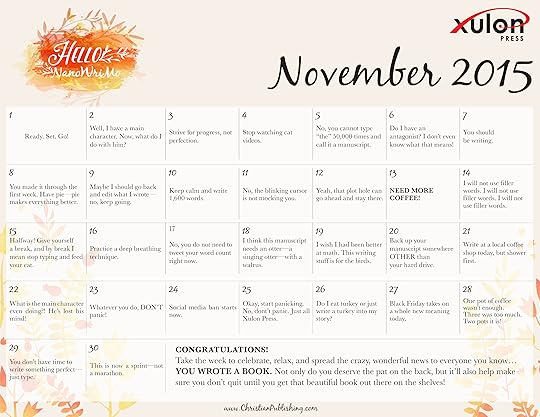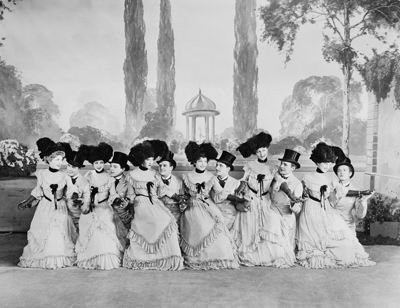Peter Lopez Jr.'s Blog: Xulon Press Blog , page 40
November 9, 2015
How To Set Up a Book Signing – An Interview with Xulon Author Bob Bush

What is one of the most effective way to find and meet new readers? Book signings! Xulon Press editor Blair Townley interviews author Robert Bush (Shortcut to Heaven, the Janitor Brigade and the Visitor), who has held 137 book signings, as he dispenses vital advice on how to set up a book signing—and why they’re so important to an author’s success.
Blair Townley: Thank you, Robert, for taking part in this interview. After the printing of your books, what was your plan to market them?
Robert Bush: My background is in sales and marketing, with a business degree in business marketing and an MBA in market strategy. You want to identify your market strategy and audience beforehand. Anybody who is going to launch a book needs to put together a business plan and really understand what it means to sell a book. You need to understand what you are selling the book for and what the store is picking up [with your book]. It is also important to have realistic expectations; a lot of people get discouraged because they are not moving the books like they want.
I really think it is also important for authors to convey a professional image. I have a website, press releases and videos from Xulon Press, while also being linked into e-book availability with Amazon.com. You really want to differentiate yourself from other books and authors. Yet, I think the most important tool is face-to-face communication with others.
BT: Were book signings at the forefront of your market strategy plan? How did you go about making connections at bookstores?
RB: Books signings are where you move most of your books; there’s no doubt about it. You are going to see residual impact after the book signings because people will come back. When I was really active in book signings, I would see significant residual impact there.
Setting up a signing requires the author to meet with the manager of the store. He/she has to go to that manager and get the person excited to show that book in the store. Most of these managers are going to try to blow off the author, but you need to challenge them to give you the opportunity for one signing. That is how all I was able to get all my signings, just asking the store managers for one day.
The manager’s concern is whether you will be a distraction to the store, or extension of the store. It’s important for the author to convey that he/she is an extension of the store and will work the store, but won’t get in the way of normal business flow.
BT: What all did you do to prepare for the book signing on the actual day?
RB: I wear a suit and tie to book signings and I work the floor, never sitting. You can’t be an introvert and move books. I show up fifteen minutes before the appointed time to set up my signing. If the signing is at 9, I’m there at 8:45 so by 9, I’m ready to go. I meet with every member of the staff and have actually sold a lot of books to staff members at the stores. Every person gets a business card, and I’ll even be in the bookstores’ coffee shops talking to people. I have posters with my book covers for my signings.
I’ve also done a number of radio interviews and have a radio interview on my website. When you are going into a signing location that has a radio station, I would encourage authors to reach out to that radio station and get some advertising.
It’s a huge advantage to have multiple books at a book signing, too, so you can have a strategy for each book. You can get pretty good at leading people to certain books from first impressions, while also giving them an opportunity to pick. I gauge their reactions to see what they might be interested in, and some customers have bought all three books.
BT: How did you go about choosing places for book signings?
RB: If you are in a location where you know the stores, that’s good. Most of your stores are chains and most authors will run into problems with book signings there because of inaccessibility to managers. There are just not a lot of independent bookstores around anymore. Authors need to know their own geographies and go after the busy stores. Even if it is a chain account, it comes down to the manager deciding. I now know every store, and they have gotten to know me over the years.
BT: How many people have attended your signings?
RB: I sell an average of twenty-five books at a store, but you are reaching out to a lot of people in the course of that time. Most of the sales that you make, more than ninety percent, are cold calls when people walking in the door have no idea who you are. I’ve invited people to buy the books as well, but to depend on friends and family to buy the books means you are going to run out of that list pretty quickly. You have to be genuine and open to coming up to people you don’t know.
I’m also a big believer in where you position yourself in the book signing. My choice location is to be in a high-traffic area but I don’t want to be five feet in front of the door. People don’t want to walk in the door and be hit with someone trying to sell something to them. You need to work with the manager to position yourself where you get traffic without catching people off-guard. I’ll walk the floor if no one is at my table and talk to people, giving them my card.
BT: After each book signing, have you re-evaluated the signing to see what needs to be changed?
RB: I see every signing as an opportunity to learn. If you tap into something that’s working, you will continue to move forward with it. You think about what worked and what didn’t, but you have to know how to close.
A lot of authors are pretty introverted, so what I would recommend is that they be willing to put in a long day [sometimes eight to ten hours], enjoy what they are doing, don’t get frustrated, prepare early, and have fun. The authors need to look at the signings as an opportunity to serve Jesus in many dark places. You peel back a layer at book signings of people that you never would have an opportunity anywhere else. Learning from your signings is pretty critical.
Book signings for me are a ministry, meeting people who really need to feel encouraged. I believe God puts people in front of me in the store for a reason and if I can make a difference in their lives, that’s why I’m there. The selling of the books will come, but you have to be really genuine and love people. The stories you hear from people are amazing and it is a humbling time to serve. I meet a lot of parents with kids at signings and they tell me their children love to write. I tell them my story; I was a kid who loved to write and then life took over. I went to college and was in the business world for many years, but the passion to write never leaves you and you never know when God will open that door again. So if you love to write, don’t give up on that.
The post How To Set Up a Book Signing – An Interview with Xulon Author Bob Bush appeared first on Xulon Press, Christian Self Publishing.
November 2, 2015
Still Dreaming of Writing a Book? Here’s How To Do It In 30 Days.
November is a busy month for writers: it’s National Novel Writing Month, also known as NanoWriMo.
What happens during NanoWriMo? Simple: to celebrate the only official book-writing month of the year, writers are encouraged to spend 30 days putting their fingers to the keyboard, completing a 50,000 word book by November 30th.
One month. Boom. Done. You’re one step (a first draft) closer to becoming a published author.
If you have struggled with finding the time and discipline to finish your book, this is one of the easiest ways to jump those hurdles. Your word count can vary from day-to-day, but you will write an average of 1,667 words per day—a totally manageable number.
Throughout the month, we’ll be sharing tools, tips and tricks to finally getting your book done. We’re here to encourage you through the process!
2015 is wrapping up. How much would you love starting 2016 by telling your friends and family that you finally wrote that book?
Happy #NanoWriMo,
Erika Bennett

The post Still Dreaming of Writing a Book? Here’s How To Do It In 30 Days. appeared first on Xulon Press, Christian Self Publishing.
October 27, 2015
5 Ways to Paint Autumn into Your Writing
How to Write About Fall
There’s a reason one of the first pieces of advice any professional offers to a new writer forging ahead on the publishing journey is, “Show, don’t tell.” Readers don’t want to be told, they want to be shown. So, how does one show information? If we use seasons or weather as an example, which can be used for metaphorical purposes within the telling of a story, we can begin to crack the code on showing, and not telling, information to the reader.
Since most of The States are experiencing autumn right now, it’s a great example to use. Autumn is a time of change; the temperatures fall and leaves turn colors before they drop from their trees. If you have a character in a major state of transition, run their life-change parallel with the change of the season. By doing so, you’ll be showing the reader not only the physical elements of the season, but you’ll also be showing them the emotional or physical transition of the protagonist.
So, how do you show your reader autumn in your book? There are five ways to paint autumn into your writing. You know them as the five senses: sight, sound, smell, taste, and feel (touch). If you can harness the power of the senses, you can show anything you want to your reader. Showing is more about tapping into the reader’s imagination and letting them run with the idea than it is about providing cold hard facts.
What triggers your senses during autumn? Make a list of what comes to mind when you correlate your senses to the season.

Once you’ve noted everything your senses recognize about autumn, you can begin to weave them into your story. I’ve provided an example below of how I used my notes to add texture and description without telling readers anything.
A woman stood next to Erin at a secluded stop on the Blue Ridge Parkway; both looking out over the vast reach of the mountain range, and the mixture of apple red, fiery orange, and muted yellow that washed over the mountainside closest to them. Though, neither woman saw the same view as the other. Erin, feeling tumultuous as she entered an unexpected season of change, saw past the swaths of color painted across the mountainside; instead, her mind wandered to the beautiful, vibrant leaves that had already fallen to the ground and then turned brown and brittle. One footstep would crunch those leaves into a million tiny pieces, which is exactly how Erin felt at that moment. She sipped another spicy, sweet taste of her pumpkin spice latte, hoping for warmth, but still felt bone-chilling cold inside. Erin turned to watch the woman standing next to her. The woman had a large camera, with a long lens, in hand—her face pressed up against the camera body. Erin could hear the click of the shutter every few seconds, and wondered what this stranger, looking out at the exact same view as Erin, saw when she looked through her lens.
Dorothy had gone up to the parkway on her day off to be surrounded by the 360-degree view of mountains swathed in the deep, rich colors of red, orange, and yellow. She didn’t look for the turning colors though. Dorothy trained her eye to find the steadfast evergreen tree—deep blackish green, speckled dots on the mountainside compared to the other trees. Dorothy always strived to be strong like the evergreen tree, standing up to the changing seasons, and withstanding the harshest winters life could throw at her. Fall wasn’t a death to Dorothy, but a second spring. She knew winter would come, and the annuals would die away, but she also knew the trees would come back to life come spring. Yes, autumn held more beauty in it than any other season, and she loved capturing those small moments of beauty as she stood tall on the side of a monstrous mountain range.
Dorothy could hear the rustling of dried leaves nearby and turned to see the woman who had been quietly standing next to her, walking in her direction. “A beautiful day, isn’t it?” Dorothy asked.
“It sure is,” Erin replied. “Can I ask you something?”
“Sure Hon.”
“What did you see when you looked through your camera lens?”
“Well, I saw the beauty of changing seasons, but I also looked for the evergreen trees. They are far and few between the swaths of golden yellow and fire engine red, but they are there nevertheless.”
“Why do you look for the evergreens?”
“They are somewhat of a reminder to be strong in the face of the changing seasons of life. Whenever I need that reminder, I come up here.”
The post 5 Ways to Paint Autumn into Your Writing appeared first on Xulon Press, Christian Self Publishing.
October 8, 2015
Hello, My Name Is: How a Great Intro Will Chart Your Book’s Path.

Why Writing an Introduction Helps Chart Your Book’s Path.
Imagine you have a map in front of you, but for some reason there is no starting point to lead your journey in the right direction.
The same sentiment can be felt when you read a manuscript that doesn’t have a Preface/Introduction/Prologue section to briefly explain to readers the purpose of the book; it gives a fifty-fifty shot to readers of whether they will understand the book’s purpose within the first few pages or not at all.
So, what better way to begin your book “on the right foot” than by creating an engaging and informative introduction to heighten readers’ interest for your book—while also clearly stating its premise?
It is not mandatory to have an introduction, but it is a great way for all your readers to be at the same starting point on your book’s “map” before beginning the first chapter. When writing an introduction, remember what the definition of an introduction is to briefly state what the book is about and what readers are to gain in lessons or insight from reading it. You don’t have to give a long, drawn-out explanation of your book when a few well-crafted sentences will suffice.
If you are writing a fictional manuscript, decide how much of the storyline (plot, characters, major conflict) you want to expose. Your goal is to hook readers, without giving so much away that they don’t finish the book. Shape the introduction as that of an “elevator speech” for a job interview: in the time of an elevator ride (or first couple of pages in the manuscript), tell readers all that they need to know about the book without giving away the ending.
Writing a book is like that of traversing a trail toward a destination, so begin your journey in the right direction for you and your readers with an introduction that lights the path ahead for your manuscript.
The post Hello, My Name Is: How a Great Intro Will Chart Your Book’s Path. appeared first on Xulon Press, Christian Self Publishing.
September 30, 2015
Haven’t you heard? Books are the new black.
 The newest numbers confirm what authors, book lovers and the publishing industry have all secretly known: People still love books.
The newest numbers confirm what authors, book lovers and the publishing industry have all secretly known: People still love books.
And they like the old-fashioned kind. Not just the kind of books you read on devices which require wall chargers.
Polls show that Millennials (roughly defined as those between the ages of 18 and 34 in 2015), prefer printed books to e-books. The same generation that single-handedly resurrected vinyl records and record players, implemented a resurgence of bow ties and barber shops, and made vintage glass-bottled sodas cool again, is also all about feeling the weight of paper, binding and a crisp cover in their hand. What was old is new and cool again.
E-books sales dipped slightly in 2015, but sales of printed books have gone up steadily since 2014, even causing the New York Times to boldly declare: “Print is far from dead!” A Nielsen study showed that the number of people who preferred digital books to printed fell to 32% in the first quarter of 2015, from 50% in 2012. When specifically examining younger demographics, the number is surprisingly lower: just 20% of teens, 25% of 30–44 year-olds, and 23% of 18–29 year-olds prefer e-books to printed copies.
This generation grew up with computers, and most went off to college toting a device from the very first wave of smartphones. Experts surmise that the over-digitization in their lives is what has led Millennials to pick trends that point backwards—to authenticity, tradition and good taste.
And the Christian book market specifically? Despite the internal struggles of some Christian bookstore chains, the numbers show that the audience is active and hungry: book sales jumped by 10.5% in 2014, grossly out-gaining mainstream book sales which grew at a still-respectable 2.4%.
Whether readers are choosing screentime or papertime, authors and publishers alike should feel encouraged, as book sales in general have been rising since 2012. The trend is clear—books are back in again!
The post Haven’t you heard? Books are the new black. appeared first on Xulon Press, Christian Self Publishing.
September 29, 2015
Passive Voice: It’s So Passé

Passive voice has a time and place in writing, as it serves to be a stylistic additive in many books and papers. In some cases, people prefer passive voice in creative pieces, such as poetry and prose; however, writing in passive voice too often in your fiction and non-fiction pieces can cloud your writing. The “passive voice” can best be described as writing that quietly emphasizes the subject in the sentence, rather than the verb. It also indirectly guides the reader to a course of action or situation without a direct voice, which can leave readers scratching their heads. It dampens the tone in your writing, and can even show inconsistency where dynamic, active, confident tones could be.
Here’s an example: “I was called an offensive name by someone last night.”
Let’s take a look at works and what doesn’t. What works here is there is a completed sentence with an identifiable conflict or issue. What doesn’t work here is the lack of specific, concrete and direct tones, which readers would want more of. The reader will be asking, “who did this?” Details are lacking, and the example doesn’t emphasize action.
A clearer, more direct way to say this would be: “Sal called me an offensive name yesterday.” Here, the sentence reveals crucial detail.
Keep this in mind when you write, and create a narrative voice that sounds more direct, clear and articulate!
The post Passive Voice: It’s So Passé appeared first on Xulon Press, Christian Self Publishing.
September 10, 2015
Xulon Press Proudly Announces Winners of September 2015 Christian Writers Awards Writing Contest
 MAITLAND, FL— Xulon Press was excited to once again extend the opportunity to Christian writers to have their work recognized and be rewarded. Besides the great honor of being named September 2015 Christian Writers Awards Writing Contest winner, the grand prize first-place winner will receive a Xulon Press Elite Publishing Package (valued at $8,780).
MAITLAND, FL— Xulon Press was excited to once again extend the opportunity to Christian writers to have their work recognized and be rewarded. Besides the great honor of being named September 2015 Christian Writers Awards Writing Contest winner, the grand prize first-place winner will receive a Xulon Press Elite Publishing Package (valued at $8,780).
Of all the outstanding entries received, three winners were chosen. The September 2015 Christian Writers Awards Writing Contest winners are: in first place, An Unexpected Friend by Terry Ingalsbe, second place, The Clock of the Covenant by Nyle Kardatzke, and in third place, Lord, I Thought You Answered Prayer by Glenn Lawrence.
Xulon Press is pleased to congratulate each and every talented author that participated in the September 2015 Christian Writers Awards Writing Contest. A special congratulation goes out to all of this year’s winners. To all: Remember to continue pursuing the dream God has instilled, and stay tuned for the next Christian Writers Award.
Xulon Press, a division of Salem Communications, is the world’s largest Christian self-publisher, with more than 12,000 titles published to date.
The post Xulon Press Proudly Announces Winners of September 2015 Christian Writers Awards Writing Contest appeared first on Xulon Press, Christian Self Publishing.
September 3, 2015
Back to “School” To Re-Start Your Book
 The idea has been realized; the outline has been established; maybe a couple of pages have already been written for the book that has been placed on your heart to write.
The idea has been realized; the outline has been established; maybe a couple of pages have already been written for the book that has been placed on your heart to write.
Yet as with all writers, regardless of education, skill set or experience, obstacles will come about to impede progress and, if left unchecked, will cause a promising book to be shelved indefinitely.
One recognized obstacle that can emerge happens to occur within the writer, you: the belief that you don’t have business writing a book on this particular topic. Such a thought could be disastrous to the incubation of a manuscript, as you could let fears and doubts cause you to give up the book and the publishing dream.
However, a great approach to adopt to re-ignite those writing fires is to go “old school”, in the sense of back to the times of writing book reports, papers and essays.
When a teacher gave you a writing project/assignment in school that required research, the most important step you took was to find resources to help educate you on the assignment’s topic and prepare you to write out the assignment.
The same step can be used for writing your book, although instead of getting encyclopedias and Internet articles, you would get books on the same topic/concept/book format as your book.
If you were thinking of writing a devotional, find some inspirational devotional books that cater to the topic you want reflected most in your manuscript. The same for memoirs, children’s books, Bible-focused texts and any other book idea in mind.
As you are reading these example resources, take notes, as you did in school, on the pros and cons you have about the author’s writing and grasp of subject, as well as what lessons you can gleam from the formatting, organization, narration and pace of the book. After making the list, determine the area(s) where you find it difficult to progress in your manuscript and see if the lessons you gained from the other books can alleviate that issue.
It may sound simple in theory, but by “researching” how other authors create their books, you gain more of an idea on shaping your manuscript into an inspirational and enjoyable read for your audience. You would avoid content holes where audiences could get lost or become confused by your book, achieving the impact you wish to make on your audience.
So go back to your schooling basics and revisit the homework habit of researching. Your teachers would be proud!
The post Back to “School” To Re-Start Your Book appeared first on Xulon Press, Christian Self Publishing.
August 26, 2015
Goal Management: Patience + Persistence = Progress
 Taking control of your writing dream means actively making your routine and writing goals a priority in your life. Some say writing is about inspiration, but it’s more practical than that. It’s about actively seeking inspiration while following through with an idea, and manifesting your thoughts into words.
Taking control of your writing dream means actively making your routine and writing goals a priority in your life. Some say writing is about inspiration, but it’s more practical than that. It’s about actively seeking inspiration while following through with an idea, and manifesting your thoughts into words.
This can be achieved with action and persistence. The mindset you subconsciously (or consciously) have before writing is paramount in your level of enthusiasm. In other words, be confident and focus on your immediate goals, rather than the end result. Writing from a place of doubt, anxiety, or pressure seldom creates a positive result. If the inspiration you so deeply crave doesn’t come to you in waves, seek it out in ripples. Take small daily steps to find it.
Conducting research, for example, is a great way to spot an interest, organize your focus on a particular facet, or find more information on a subject of your interest. This includes using Google, conducting research through interviews, books (or other media) or observing the world around you and being present. In the meantime, it helps to be realistic about the inspiration process; nothing happens overnight and there is no need to be perfect.
Practicing patience while making writing dates with yourself can help take the pressure off instant inspiration, allowing you to hone your craft and routine. You can break sections of your book into smaller sections. Commit to writing a magnetic opening sentence, a non-edited paragraph, or just a page at Monday morning at 7:00 a.m.; then when you’re done, reward yourself for getting closer to your goal! Making small goals for completing your book is less intimidating then focusing on writing an entire book, and empowers you to know you are actively working toward your dream.
Now get writing!
The post Goal Management: Patience + Persistence = Progress appeared first on Xulon Press, Christian Self Publishing.
August 21, 2015
How-To Write: All About Historical Fiction, Real Characters

In historical fiction, your focus as the author may be toward authenticating the setting, presenting believable characters and creating a compelling storyline that will grab readers and hold their attention from beginning to end.
What can be an aspect missed while writing historical fiction is the opportunity to allow readers access to the main characters’ thoughts, feelings and beliefs through inner monologues. The reason could be that the author may see the story as what will be the relatable factor for readers, or maybe a hesitance to put oneself into the characters’ mindsets at that particular time period and produce accurate thoughts.
Whatever the reason, it is important to remember that what readers are drawn to most with characters is not their appearances, abilities or what situations they find themselves in on a regular basis.
It is about how readers feel as they discover the characters’ personalities depicted in their inner thoughts; how those characters identify in similar ways with what is currently occurring in readers’ lives at the moment.
So, as you are creating these literary individuals for your novel, take a moment to look at each character separately and explore the situations they will be involved in within the book. Will the characters have to be leaders of some conflict; have to lose family members/friends suddenly; find they are in love with the right/wrong person; or, will they be finding their purpose in life through a relationship with Jesus Christ?
Jot down these situations on paper for each character and ponder on what typical reactions/thoughts/feelings could emerge during these situations, in comparison to the personality of each character.
As you start to write down these emotions, you will begin formulating the internal dialogue that will surface from each character, as they recognize what they are going through and reflect on their next course of action.
This exercise could also be beneficial in developing the backgrounds/pasts of your characters as well, using the successes and trials they endured previously to shape their reactions to situations occurring in the novel.
The goal is to create characters that are true to the time period of the novel, but who are also convincing individuals, authentic in their reactions and thoughts to what they are experiencing. Taking this extra step in character development will elevate your novel from literature set in a historic era to genuine, relevant characters living in a bygone period.
The post How-To Write: All About Historical Fiction, Real Characters appeared first on Xulon Press, Christian Self Publishing.
Xulon Press Blog
- Peter Lopez Jr.'s profile
- 8 followers



